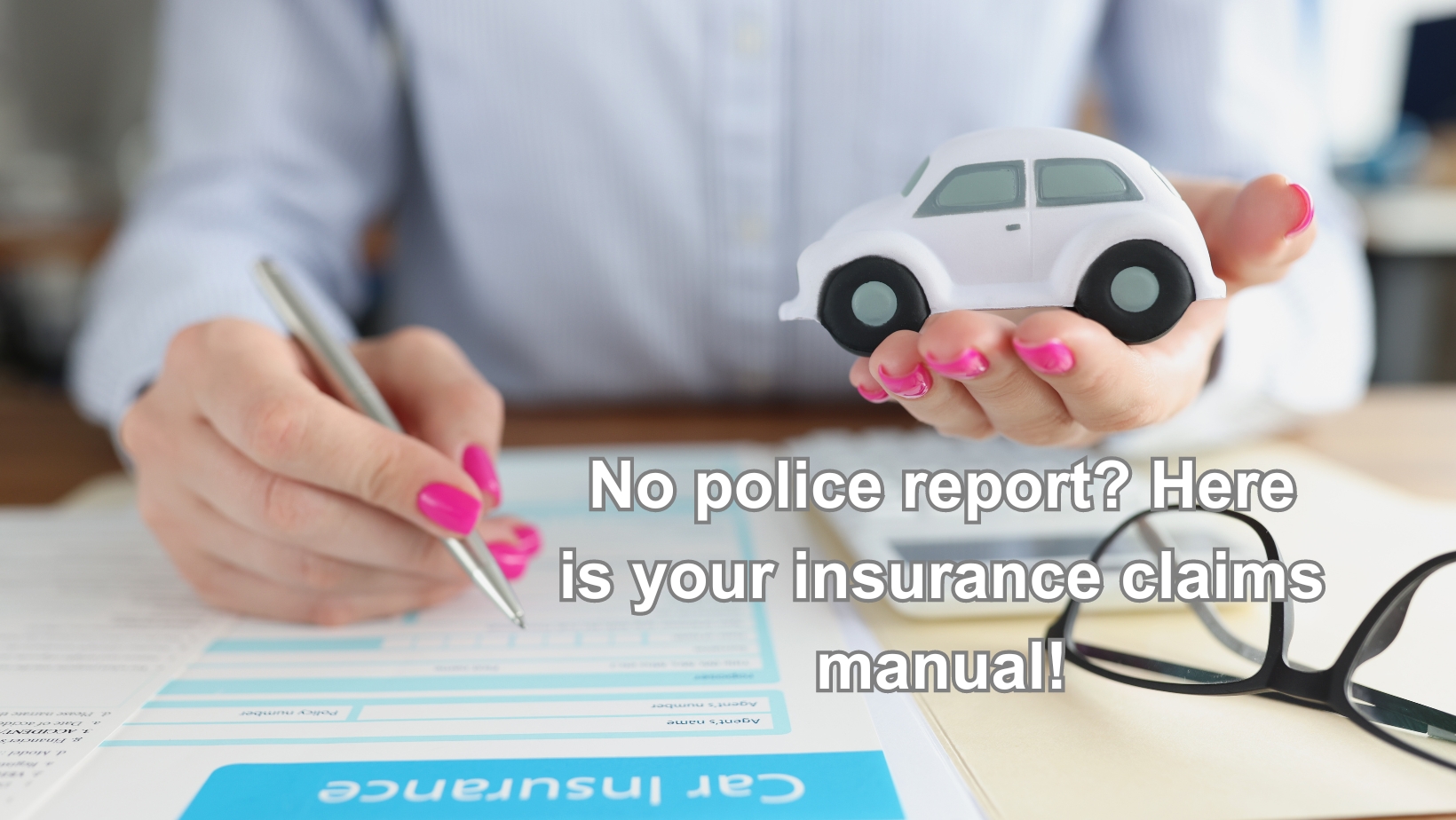You had a car accident. You and the other motorist exchanged information, then separated because no one appeared injured. The damage didn’t seem too bad either.
As no one appeared to have been injured and no property appeared to have been damaged, police declined to respond to what appeared to be a minor accident.
Your back started to hurt later that evening and you couldn’t move out of bed the next morning. A few days later, as you pulled into your driveway, a large piece of your car fell off.
“Can I file a car insurance claim without a police report? » is a question you might ask yourself after realizing the extent of your damages in an automobile accident. The simple answer is that you can always submit an insurance claim. But if there is no police report, you may need additional research to support your claim. This could delay the procedure and reduce the amount of your insurance.
Contents
- 1 Missing police report? Don’t sweat! Alternative evidence for your claim
- 2 Missing police report? Expect delays and lower offers
- 3 Understanding Insurance Coverage Without a Police Report
- 4 Get Expert Help with Your Car Accident Claim
- 5 Get It in Writing: Why Police Reports Matter After an Accident
- 6 What is a control arm?
- 7 Symptoms of a Damaged Control Arm
- 8 Can I drive with a faulty suspension arm?
- 9 How much does it cost to replace a control arm?
- 10 Final Thoughts
- 11 Frequently Asked Questions
- 11.1 Can I submit a claim to my car insurance for an accident without a police report?
- 11.2 Following a minor accident for which no criminal record has been filed, what should I do immediately?
- 11.3 If there is no police report, how can a car accident lawyer help you?
- 11.4 Without a criminal record, what kind of evidence can support a car insurance claim?
- 11.5 Even if the accident is minor, should I still report it to the police?
- 11.6 What are the consequences of not reporting a car accident to the police?
- 11.7 Can the other driver and I agree not to call the police in the event of a minor accident?
- 11.8 If there was no police report and the accident was minor, should I still contact my insurance company?
Missing police report? Don’t sweat! Alternative evidence for your claim
A police report details the accident shortly after it happened. This is therefore an important piece of evidence. Information from conversations with both parties to the accident is included in the document written by the police officer, an impartial third party. Insurance companies pay close attention to the information in police reports when negotiating claims, even though it is not always admissible in court during litigation.
Let’s say no police report is available for your car insurance claim. In this case, you can still obtain many of the benefits that the report would typically provide to an insurance applicant by using other forms of evidence, such as driver statements, eyewitness accounts, videos, diagrams, and notes on the accident, as well as images of the accident scene and damage to the vehicle.
In addition to the crucial details you can independently verify, a police report also documents the weather and road conditions at the collision scene, the date, time and location of the collision, as well as a written details of the vehicles involved.
An adjuster can be dispatched to assess your car and the accident site throughout the claims process. Many of the gaps that a police report may have filled can be filled simply by looking at skid marks on the road, examining visual cues on your car, and performing a technical evaluation of your vehicle. Regardless of the adjuster’s decision, you can always assess the condition of your car by consulting a third-party mechanic or body shop.

Missing police report? Expect delays and lower offers
Without a police report, you can still file a valid auto insurance claim, but the processing time for your claim will likely increase. A claim that must contain reliable information found in a police report will be reviewed by many insurance companies, which can cause delays. As the insurer knows, you will not have access to a criminal record or the testimony of a police officer during a trial; Car insurance claims without it may also result in lower settlement offers.
But, as we mentioned, many of the problems when an auto insurance claim is filed without a criminal record can be minimized or eliminated by carefully gathering and presenting the facts regarding your collision. Additionally, having legal representation helps ensure that the insurance company receives a full presentation of your acquired facts.
Understanding Insurance Coverage Without a Police Report
Even without a police report, your insurance company can still compensate you if you were injured in a car accident. Since each insurer has a different policy, you should review yours to see exactly what is covered.
An attorney can help you understand your insurance company’s policies and how to proceed with your property damage and injury claim at this appointment.
Get Expert Help with Your Car Accident Claim
A police report can significantly increase your chances of obtaining the maximum compensation you are entitled to if you have been involved in an automobile accident. Having a police report also speeds up the claims process. However, if you want to file a claim for compensation for your car accident, a police report is only sometimes necessary.
Even without a police report, you should still contact the insurers. But before contacting your insurance company, consult an attorney. The compensation claim process is complex and you need to avoid making mistakes.
Since insurance companies are big businesses, they will do everything possible to avoid having to pay out. They will wait until you do something wrong to use that as an excuse to deny you the money you are owed. You can get advice from an attorney at our firm on what to say and how to file a personal injury claim. It would help if you never took responsibility for your accident.

Get It in Writing: Why Police Reports Matter After an Accident
You should immediately notify authorities if you are involved in a car accident. Even if you think the accident was minor, asking a police officer to record the incident and file a report could be very helpful if you ever need to make a compensation claim.
You are entitled to a copy of the police report if you were involved in a car accident and were called to the scene. You should contact your lawyer if you have not received one or if you have lost your copy. They can obtain a new copy from the nearby police station.
Talk to your attorney to find out if a police report has already been filed.
Although it is not always necessary, there are circumstances in which it will be necessary to file a police report. For example, it is necessary to file a police report if the car is so badly damaged that it must be towed from the scene. According to Florida Statute 316.066, you have ten days after an accident to file a police report if any of the following occur:
- Either someone died or was injured in the accident.
- More than $500 in damage was caused as a result of the collision.
- Traffic was interrupted by the accident.
- The person driving under the influence of drugs or alcohol was at fault for the collision.
It is essential to understand that you should still try to record your accident as much as possible, even if the law does not require it. Any proof you get now will be very helpful when it comes time to get paid later.

What is a control arm?
The control arm connects the structure or body of a car to the steering knuckle. The hub attached to the steering knuckle holds the steering wheel in place. The spindle, connected to this mechanism, allows the wheel to turn left and right. This helps orient the wheel correctly and allows it to move up and down over bumps.
How does it work ?
The steering knuckle, to which the wheel is connected via the hub and bearing assembly, is connected to the control arm at one end by a ball joint known as a ball joint. It is attached to the car body or chassis at the opposite end. As a result, the arm pivots up and down with the wheel when the car goes over a bump, keeping the car body stable. In addition, this part can pivot on the chassis/body side using a socket (or a pair of sockets).
Symptoms of a Damaged Control Arm
The actual control arm could be durable throughout the entire life of the car. On the other hand, bushings frequently degrade as a car approaches 100,000 kilometers. As a result, it is vulnerable to damage if the car crashes or hits a large pothole. If the bushings are worn, the suspension will squeal when going over bumps.
Additionally, it can hit the ring supports if they are badly worn, causing metal-to-metal contact. The car may pull sideways or veer off course if it is damaged or bent, which can cause uneven tire wear.
Here are the symptoms you should watch out for:
- Vibration of the car or steering wheel
- Uneven tire wear
- Reduced steering responsiveness
- A feeling of vibration when driving
Can I drive with a faulty suspension arm?
A car’s control arm will be out of alignment, causing uneven tire wear and poor car handling if it is damaged in a collision, impact with a pothole, or otherwise. a collision with a parking block. It is imperative to replace this damaged part as soon as possible.
When the car drives over bumps, an annoying squeal will be heard if the control arm bushings are worn. A car with a damaged control arm may roll. However, if the bushings deteriorate sufficiently, metal-to-metal contact could occur between the part and the bushing support. This could lead to further damage to the suspension, requiring the part or bushing to be changed.
How often should the control arm be replaced?
Although there is no set interval for replacing it, as a car approaches 100,000 miles, the bushings may wear out and need to be replaced. Additionally, the life of these mechanism bushings may be shortened by aggressive driving or driving over rough terrain.
Stages of diagnosis
A technician can identify a worn lower control arm during a test drive.
A bounce test, in which the technician presses hard on a corner of the car to make the suspension bounce and rotate the parts, can also reveal the fault. Since this mechanism influences the position and angle of the wheel, damaged or bent parts may appear during a four-wheel suspension alignment.
Replacement steps
For lower control arm replacement, a technician must first lift the car into the air, support it, and then remove the wheel and tire. Second, the lower ball joint, connected to the steering knuckle, and the chassis or car body must be disengaged from the lower control arm. Third, the top of the steering knuckle and the strut tower on the body are separated from an upper control arm.
While some parts already have bushings installed, others need to be fitted with bushings. Related parts, including ball joints, tie rod ends and stabilizer bar links, are frequently changed simultaneously. However, the suspension alignment will be hampered if the arm is damaged.
Likewise, heat, petroleum compounds, and oil can also damage rubber bushings. Therefore, you should also ensure that the bushings are clean and free of grease or oil through routine inspections.
How much does it cost to replace a control arm?
The cost of replacing a control arm should average between $500 and $750. Prices may also differ somewhat depending on whether a front or rear part needs replacing, depending on the make and model of your car. Typically, a new car control arm costs between $400 and $550. If you take your car to a repair shop to replace the damaged part, labor charges will cost you an additional $150 to $200.
For example, replacing the lower control arm will cost between $370 and $730, while replacing the right front control arm will cost up to $1000.
Can I replace a suspension arm myself?
Replacing is often a mid-level DIY project. On some cars, the bushings are already attached to the part.
In some cars, the bushings must be installed into the mechanism and pressed into their seats. Repair will be more difficult in this situation. To perform this repair, the car must also be lifted and supported safely with a jack and jack stand. Serious harm or death may occur if not done safely.
Final Thoughts
Way.com advises checking the ball joint at the same time as changing the control arm. Since this mechanism determines the location of the wheel and tire, it is also advisable to align all four wheels after replacing the control arm.
There is no need to immediately replace a damaged control arm. This is advisable as it can prevent more costly suspension problems in the future.
Safety on the road depends on proper suspension, but it also depends on having appropriate insurance. Finding low fares is now easier than ever, thanks to Way.com. Using Way.com will save you from dealing with a ton of paperwork.
Frequently Asked Questions
Can I submit a claim to my car insurance for an accident without a police report?
In fact, you can still make a claim with your car insurance even without a police report. A criminal record is helpful, but it is only sometimes required to make a claim.
Following a minor accident for which no criminal record has been filed, what should I do immediately?
After a minor collision, give the other driver your insurance information and take photos of the situation. Additionally, writing down witness contact information is a good idea. When submitting your insurance claim, this information may be helpful.
If there is no police report, how can a car accident lawyer help you?
To establish the facts of the case, a car accident lawyer can help gather other types of evidence.
Without a criminal record, what kind of evidence can support a car insurance claim?
Evidence such as photos of the accident scene, witness statements, and medical records can take the place of a police report. In addition, statements from both participants in the accident can be provided.
Even if the accident is minor, should I still report it to the police?
Regardless of how serious the collision is, it’s usually a good idea to report it to the police. By doing so, the accident is officially documented, which is advantageous for insurance and legal reasons.
What are the consequences of not reporting a car accident to the police?
Ignoring the need to file a police report can make it more difficult to establish fault. It also increases the likelihood of an unsuccessful insurance claim. If the other motorist later disputes the facts of the accident, this can also become embarrassing.
Can the other driver and I agree not to call the police in the event of a minor accident?
This is generally not a good idea. It may be easier to resolve disagreements about the accident if there is a police report.
If there was no police report and the accident was minor, should I still contact my insurance company?
Yes, you must always report any accident to your insurer.






